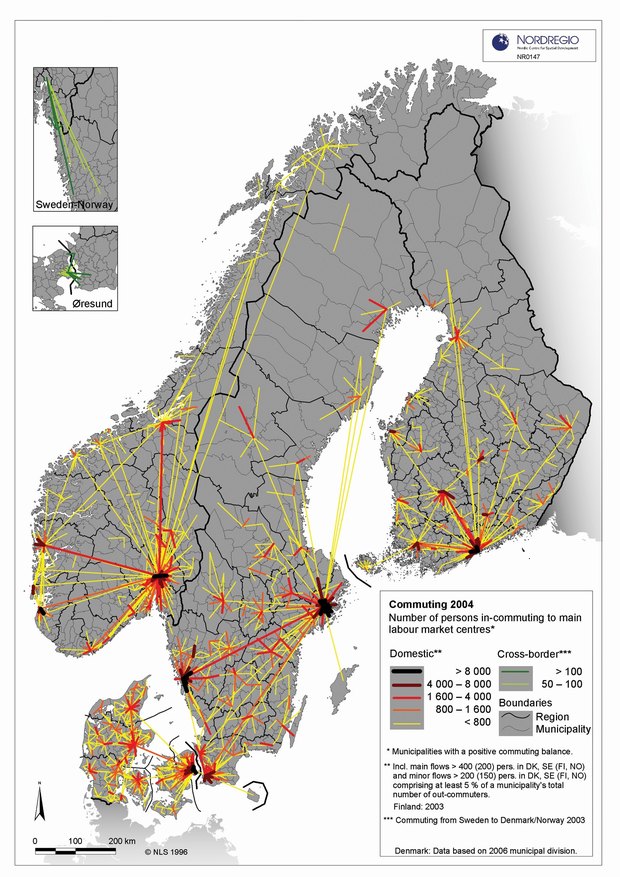In Denmark almost every second employed person commutes to work across a municipal boundary whereas in Finland, Norway and Sweden it is around every third person. For Iceland exact statistical information on commuter flows is not available. However, today some 70% of the Icelandic population resides in commuting distance to Reykjavik city.
The map, which is one of the illustrations in the new report, depicts the main commuter flows towards those municipalities maintaining a commuter surplus. In 2004 this was the case for roughly one in five municipalities in Denmark, Finland, Norway and Sweden. The major part of these municipalities are either cities or nearby municipalities.
Significant commuter ties beyond the local level exist between capitals and second or third-order urban centres in particular but also from/towards the other regional administrative centres.
In Helsinki the accumulated number of in-commuters from all regional administrative centres in Finland comes to around 9% of all in-commuters on the capital labour market. The corresponding figures for Tampere and Turku are 7% and 5% respectively.
On the Stockholm labour market the importance of this group is almost the same as in Helsinki while Gothenburg and Malmö clearly attract less commuters from other Swedish regional centres as compared to the Finnish proportions. In Denmark the pattern is the opposite with Århus (7.5%) having more than twice as many of this group of commuters as compared to Copenhagen.
Norway stands out with a generally high share of long distance commuters on its labour markets. Around one in ten (9-11%) of in-commuters on the Oslo, Bergen and Trondheim labour market originate from the other respective Norwegian regional administrative centres.
Intra-Nordic
On an intra-Nordic scale the volumes of commuter flows are lower but of particular regional relevance in two Nordic cross-border areas, namely in the Øresund area (Denmark/Sweden) and along the southern Norwegian-Swedish border. In the latter area more than half of all cross-border commuting in the Nordic countries is taking place.
In 2004 a total of 20 593 persons commuted from Sweden to either Norway or Denmark. In the opposite direction commuter flows amounted to a mere 1 153 and 692 persons respectively.
While commuters to Denmark mainly target greater Copenhagen and Helsingør, it is Oslo and its eastern surroundings (Akershus, Østfold and Hedmark County) in the case of Norway.
In a Swedish border municipality like Strömstad (Västra Götaland and Värmland) more than 10% of the employed population out-commutes to a Norwegian destination. Moreover noteworthy mutual commuter flows also exist between Oslo and Gothenburg.
The establishment of the Øresund fixed link at the beginning of the decade has favoured both Copenhagen and Malmö's labour markets by contributing to the solveing of labour shortages in the Danish capital while reducing unemployment in the Malmö area. At the Swedish-Finnish border minor commuter flows arise between the adjacent municipalities of Haparanda (SE) and Tornio (FI) as well as in respect of the Finnish Åland islands and the region of Södra Österbotten (Vaasa). Those flows, being small in a Nordic context, can nevertheless be important at the local level. In Haparanda commuters from neighbouring Tornio occupy more than one out of ten jobs. Flows in this direction are double those the other way around.
Nordic capitals
Commuting between the Nordic capital labour markets is less intensive and mainly takes place between Helsinki and Stockholm (1 400 commuters).
The same holds true for commuting from/to adjacent EU labour markets. At the Danish-German border the number of commuters in the main flow from Schleswig-Holstein (DE) towards Sønderjylland (DK) amounts to a mere 1 694 (2003) but has significantly increased since the end of the 1990s.
Another issue discussed in Regional Development in the Nordic countries 2007 is jobless growth, while the loss of jobs in the core cities is also examined. For example, between 2001 and 2003, Helsinki, Oslo and Stockholm lost some 4 500, 14 700 and 19 000 jobs respectively. In Helsinki and Oslo the core city comprises 85 % of all jobs on the capital labour market. In comparison, in Copenhagen city roughly half of all jobs are located inside the city and the loss was less.
Primarily the core cities are challenged by their own surroundings, though larger regional centres are also gaining jobs. Among these, in particular universities seem to have played a distinct role in facilitating job creation.

By Odd Iglebaek